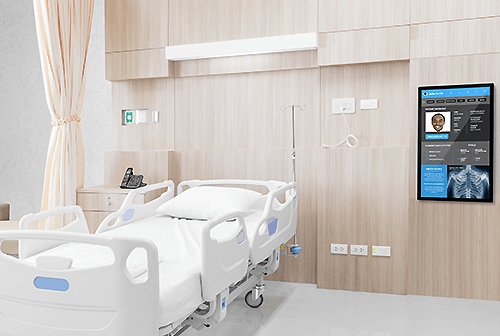August 24, 2021
Smart Hospital Rooms Make Patients a Part of the ProcessSmart Hospital Rooms Make Patients a Part of the Process

For decades, little thought went into the design of hospital rooms. They needed to fulfill various functions — as a recovery space for patients, as a visiting room for friends and family, and as a workspace for clinicians — and they fell short in almost every way.
Research revealed that better-designed rooms lead to a variety of positive outcomes: fewer falls, lower infection rates, shorter stays, and even a decreased use of pain medication. So, as newer facilities were designed, patient rooms would now have amenities like plenty of natural light, views of gardens and other green spaces, and more flexible furnishings and storage. That thought process extended even to nursing stations, which were redesigned to better accommodate patient needs and shifting clinician workflows.
So now that we’ve reimagined the physical space, how do we make the rooms smarter? We’re already making great strides creating interactive rooms that can sense who’s inside and subtly change the environment. Software providers are taking interactivity to higher levels by replacing outdated whiteboards with interactive displays that communicate to the patient while also enabling clinical workflows. And perfectly suited for these displays are Elo’s large-format touchscreens, whose sizes ranging from 32-inch to 55-inch are perfectly suited for creating a unique digital footprint for accessing and displaying key medical data to help clinicians more effectively engage patients and their families.
Similar technology is changing how rooms are managed. Digital room displays outside the patient room are transforming how caregivers, hospital staff and friends or family members are notified of patient status or conditions relating to the patient. Elo’s Edge Connect technology accommodates status indicator lights to be fixed to the displays to indicate room status or critical patient condition information. Gone are the days of utilizing colored pieces of paper taped to patient room doors notifying of a fall risk, allergy or DNR status.
The latest technology is even transforming hospital beds into diagnostic tools. They can check a patient’s weight or positioning and update the patient record automatically to inform clinicians of possible risks. If a patient needs assistance walking, the smart beds can sense when they try to get up and notify nearby staffers.
This adoption of technology enables the vision smart hospitals have tried to convey for many years. Elo is squarely positioned to assist medical device makers and healthcare providers in all aspects of interactivity through our various touchscreen display products.
Another example of how technology is transforming patient experiences during their stay is with the television commonly found in hospital rooms. What healthcare providers are now doing is augmenting the television with interactive touchscreen displays within easy reach of the patient.
At NYU Langone Medical Center, for instance, bedside touchscreens allow patients to connect with their families, order and schedule meals, control the lighting and temperature, and select on-demand TV content just as they would do from home. The experience is personalized in many ways. If a patient can’t eat certain foods, a hospital can make sure those foods don’t appear on that patient’s menu. After undergoing surgery, a patient can watch videos about the recovery process. This personalization enhances the experience, leading to improved outcomes and justifying the costs associated with implementing these new technologies.
In collaboration with a wide range of companies, Elo is striving to bring next-generation technology to hospitals. Redesigned rooms result in improved experiences for patients and improved financial performance for the healthcare provider. Research shows that creating a collaborative environment where patients have a greater say in their healthcare can accomplish far more than originally thought.
Reach out to Elo today to discuss how we can support your goals in creating smarter hospitals and smarter patient experiences.